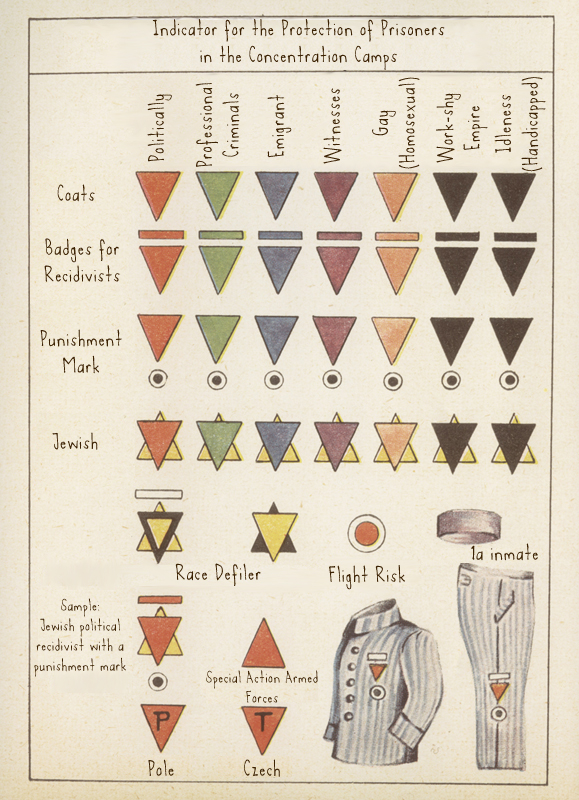The image to the right shows wedding rings taken from Jews who were to be exterminated.
Photos like this highlight the personal realities of the horrors of the Holocaust

Topics on the Page
What was the Holocaust?
History of the Holocaust
Concentration and Labor Camps
Extermination Camps
Ghettos
Pogroms and Death Squads
Why/How the Holocaust Happened
Heroes of the Holocaust
Women of the Holocaust
 CROSS-LINK: Anne Frank and the Diary of a Young Girl
CROSS-LINK: Anne Frank and the Diary of a Young Girl
Multicultural/LGBTQ History
Teaching Resources and Learning Plans
- The Voyage of the St. Louis
- Books and Films
 Cross-Links
Cross-Links
Focus Question: What was the background, course and consequences of the Holocaust?
6 million Jews and 5 million people - including European Roma (Gypsies), people with disabilities, homosexuals, and Polish citizens - were killed during the Holocaust,
making it one of the worst genocides ever witnessed by mankind.
What was the Holocaust?
The Holocaust (1933–1945) was the systematic, state-sponsored persecution and murder of six million European Jews by the Nazi German regime and its allies and collaborators.
Antisemitism was the cause and the start of the Holocaust, it was a founding ideology in the Nazi regime and was also widespread around Europe.
- Many German born and raised citizens felt a sense of pride in their nationalism, and since Jewish people had migrated to Germany, there was an "us vs them" mentality.
- Joined with the fact that many Jewish citizens had high social class positions in society, this was where antisemitism began in Europe. People felt that these kinds of high class jobs should be reserved for people born from the nation. This ideology and jealousy played an important role in the Nazi party gaining control in the first place.
Links from the United States Holocaust Memorial Museum
This website has a wealth of resources. It contains informational pages, oral histories, ID cards and personal histories of Holocaust victims, timelines, maps, and more.
Read an overview of the Holocaust here
Read about the concentration camps here
Read about the genocide of Roma/Gypsies here
Read about the genocide of the disabled here
Read about the genocide of homosexuals here
Read about the genocide of the Polish here
Explore the Primary Source Databases from the United States Holocaust Memorial Museum here
 Multimedia Resources
Multimedia Resources
Video of Homosexual Holocaust Survivor
Video of Roma Sinti Holocaust Survivor
Video About the Final Solution
Video About the Rise of the Nazis
Museum of Jewish Heritage Link- Provides access to primary sources, educational lessons, virtual tours, and more for teachers/students.
New Orleans National WWII Museum- Offers free primary source and other lesson material for teachers to use in their lessons.
Eternal Flame and Concentration Camp Victims Memorial

History of the Holocaust
Crash Course Video on the Holocaust
Because of mature content users are required to sign in before viewing the video to verify age.
The beginning of the Holocaust is commonly pinpointed to an event called Kristallnacht, "the Night of Broken Glass."
- Click here for videos of first hand experiences during Kristallnacht.
The course of the Holocaust can be broken down into different techniques of expulsion and extermination that the Nazis used (categories appear in red below. They are borrowed from Wikipedia):
This timeline outlines key events during the Holocaust: https://www.museumoftolerance.com/education/teacher-resources/holocaust-resources/timeline-of-the-holocaust.html
This timeline provides a list of events during the Holocaust, and clicking on each event provides more information, details and videos surrounding that particular event: https://timelineoftheholocaust.org/
Concentration and Labor Camps (1933-1945)
Because of its extreme xenophobia, Nazi Germany established concentration camps throughout its territories to intern those it believed threatened the regime. These camps were in place well before Kristallnacht, but after 1938 the number of inmates quadrupled from 25,000 to about 100,000 in 1942. By 1945, there were more than 700,000 inmates in Nazi camps [11].
The following are the names of the major concentration camps, although the Jewish Virtual Library estimates that there were close to 15,000 camps in total:
- Bergen-Belsen
- Bogdanovka
- Buchenwald
- Dachau
- Gross-Rosen
- Herzogenbusch
- Janowska
- Jasenovac
- Kaiserwald
- Maly Trostenets
- Mauthausen-Gusen
- Neuengamme
- Ravensbrück
- Sachsenhausen
- Sajmiste
- Salaspils
- Stutthof
- Thereisienstadt
- Uckermarck
- Warsaw
Many of these camps were labor camps, where prisoners were forced to do hard physical labor under conditions of starvation, dehydration, disease and psychological abuse. These camps did not have the explicit goal of extermination; however, many died due to such harsh treatment.

Primo Levi and Elie Wiesel are two Holocaust survivors who described their experiences in German concentration camps in powerful memoirs. Levi, who is Jewish-Italian, described the time he spent in Auschwitz in his memoir If This Is a Man (also known as Survival in Auschwitz), while Wiesel, who is Jewish-Romanian, chronicled his experiences in Auschwitz and Buchenwald in his memoir Night. These two novels provide a great deal of insight into the physical and mental anguish experienced by inmates of Nazi concentration camps.
Extermination Camps
Guide to Prisoner Badges in Concentration Camps, translated into English

Some of the camps had the sole purpose of killing Jews and other "undesirables." The following six camps were those designated by the Nazi party as extermination, or death, camps:
- Auschwitz-Birkenau
- Chelmno
- Belzec
- Majdanek
- Sobibor
- Treblinka
Video of Auschwitz
The most common method of extermination was death by poison gas, provided by German chemical company IG Farben. Directors of IG Farben were tried for war crimes at the Nuremburg trialsfollowing WWII [12].
A map of all camps can be found here: https://www.thoughtco.com/concentration-and-death-camps-map-1779690
Victims
- The Nazis targeted Jews, Gypsies, homosexuals, Jehovah's Witnesses, Communists, twins, and the disabled.
- For more information on the attack on homosexuals, click here.
- Some of these people tried to hide from the Nazis, like Anne Frank and her family.
- A few were successful; most were not.
- Those that were captured suffered sterilization, forced resettlement, separation from family and friends, beatings, torture, starvation, and/or death.
- Learn more about the victims of Nazi cruelty, both the children and the adults here
Click here for an oral history of Leo Schneiderman and his arrival at Auschwitz
Click here for an interactive map of Auschwitz
Click here for an overhead view of Auschwitz
A Teacher's Guide to the Holocaust -Victims
Ghettos (1940-1945)
-
The ghettos established during the Holocaust were not the first of their kind. For centuries, Jews had faced persecution and were often forced to live in designated areas called ghettos. The ghettos of WWII, however, were the preliminary step in the annihilation of Jews. These ghettos served as transition areas, as Jewish people were then sent to concentration camps and death camps.
-
In 1939, Hitler incorporated the western part of Poland into Germany and intended that the two million Jews therein were to be concentrated in ghettos in Poland’s larger cities. The five major ghettos were located in Warsaw, Lódz, Kraków, Lublin, and Lvov.
-
“On November 23, 1939, General Governor Hans Frank issued an ordinance that Jews ten years of age and older living in the General Government had to wear the Star of David on armbands or pinned on the chest or back. This made the identification of Jews easier when the Nazis began issuing orders establishing ghettos” (Holocaust Timeline).
-
Between 1939 and 1945, the Nazis established 356 ghettos in Poland, the Soviet Union, the Baltic States, Czechoslovakia, Romania, and Hungary. Smaller ghettos were generally not sealed off and were usually temporary living spaces. As for the larger ghettos, they were closed off with walls and fences and guards. However, all of these ghettos had incredibly inhumane living conditions.
Click here for a timeline of the ghettos during the Holocaust.
Click here and here for more information on the ghettos during the Holocaust
Pogroms (1939-1942) & Death Squads (1941-1943)
Pograms
 What does the term pogrom mean?
What does the term pogrom mean?
-
violent attacks by local non-Jewish populations on Jews
-
a Death Squad made up of Nazi units and police
-
a designated living space for Jewish people
-
a concentration/labor camp
The correct answer is A. B refers to einsatzgruppen, C refers to the ghettos, and D is not a pogrom. A pogrom, the Russian term for “to wreak havoc, to demolish violently” is A and occurred in the Russian Empire and other countries. Question submitted by Anna Trott (March 2024)
-
Pogrom is a Russian word meaning “to wreak havoc, to demolish violently.” Regarding the Holocaust, “the term refers to violent attacks by local non-Jewish populations on Jews in the Russian Empire and in other countries” (For more, link to Pogroms: Holocaust Encyclopedia).
-
The Kristallnacht Pogrom was a part of the orchestrated nationwide campaign of street violence. On November 9-10, 1938, Kristallnacht was a culmination of a longer period of more sporadic street violence against Jews. This event was followed by a dramatic surge in anti-Jewish legislation.
-
Other pogroms took place in Bialystok, Kovno, Lvov and Riga during World War II. Even after the war was over, pogroms continued in places like Kielce, Poland.
Click here and here for more information on pogroms.
Death Squads
-
A new stage of the Holocaust began after the Germans invaded the Soviet Union on June 22, 1941. The Nazis turned from the forced emigration and imprisonment of Jews to mass murder. Death squads or Einsatzgruppen were made up of Nazi (SS) units and police and were tasked with killing as many Jews, Communists, and Romas as they could find in the Soviet territory.
-
On December 1, 1941, a killing squad commander, SS Colonel Karl Jaeger, reported 137,346 killings in Lithuania.
Click here and here for more information on Death Squads.
Below is a picture of the SS lining up for inspection.

Common Theories for Why/How the Holocaust Happened
Intentionalism
Historians who believe that the origins of the Holocaust lay in intentionalism believe that Hitler's obsessive hatred for Jewish people led to the organized murder of millions, and that the Holocaust was planned for long before the Nazi state took over. Intentionalists believe that most of the policies of the Nazi state were primarily a result of Hitler, and that Hitler had always intended to destroy the Jews. Most of the evidence that supports the intentionalist theory comes from Hitler's autobiography called Mein Kampf, which was completed in 1925. In Mein Kampf, Hitler wrote about why he hated the Jews so much, and how he believed that there was some type of worldwide Jewish conspiracy. Hitler also wrote about the need for Lebensraum (living space) in the "Jewish-controlled east" for true Aryans, and how Aryans need to solve the "Jewish problem" for the sake of their survival. Although Hitler doesn't blatantly call for a genocide of Jews in his autobiography, intentionalists believe it is obvious that Hitler had always planned for one.
Structural-Functionalism
Historians who believe that the origins of the Holocaust lay in structural-functionalism believe that the Holocaust was the product of an unorganized, polycratic Nazi state, and that it was carried out by a lot of lower-ranking Nazi officers. Although Hitler may have provided a lot of the anti-Semitic ideology, most of the day-to-day tasks were carried out by competitive officers with lower ranks. These officers wanted to prove their worth and climb to the top of the Nazi state, and often did horrendous things on their own in hopes of being recognized. Historians who are structural-functionalists also believe that the Holocaust was not planned ahead of time, and that it was a spontaneous, last resort decision. Structural-functionalists believe that a genocide was not planned for, and was only finally decided after the Nazis were defeated at Stalingrad and in the Battle of Britain. By the fall of 1941, some labor and concentration camps were still keeping their inmates alive, while others were starting to transport the Jews and other minorities to death camps (very unorganized). After the Wannsee Conference in January of 1942, a genocide of the Jews and other minorities was finally decided on due to unexpected war losses and a general lack of a plan for what to do with the inmates of labor and concentration camps. Structural-functionalist Hannah Arendt believes that the lower-ranking officers were able to carry out these uncoordinated killings because of "the banality of evil". She argued they weren't psychopaths, but rather evil is very common and that ordinary people can do extraordinarily evil things in times of conflict and uncertainty.
Holocaust Heroes
The 'Iranian Schindler' Who Saved Jews from the Nazis from BBC Magazine describes the efforts of Abdol-Hossein Sardari, a diplomat in Paris who arranged for Iranian Jews to gain safety
Zegota, a Polish organization dedicated to providing aliases and hiding places for Jews in non-German territories saved thousands of Jews from the Nazi death camps. A movie detailing their work can be found here
Raoul Wallenberg was a Swedish diplomat who issued certificates of protection to Jewish people and helped evacuate them into neutral territories.
Huberman's List: How a Violinist Saved Jews in World War II from NPR
Click here for information on Irena Sendler, a Polish woman who helped save about 2,500 children from the Warsaw ghetto.
- Life in a Jar was created to remember Sendler and her work during the Holocaust.
Miep Gies, one of the Dutch citizens who were responsible for sheltering the Frank family during the Second World War.

Oskar Schindler after World War II

Oskar Schindler is probably the most well-known Holocaust Hero. He owned factories and would save Jewish people from being sent to Auschwitz by recruiting them to work for him. He saved over 1000 Jewish people from being killed in concentration camps.
- Click here for more information on Schindler.
- Click here to see the list of people he saved.
Sir Nicholas Winton was honored in October 29 for saving an estimated 669 Czech children during the Holocaust
 Women of the Holocaust
Women of the Holocaust
- An account of a woman who was taken to the Velodrome and eventually is able to escape.
- Alice Herz-Sommer, the oldest-known Holocaust survivor, died on February 23, 2014. She was 110 years old. Herz-Sommer was sent to a concentration camp in Terezin, a Czech city with her husband and son.
- This website is a great resource about women in the holocaust. This page is specifically about women's hair in concentration camps but also has links to other topics pertaining to women including food, caring for children and more personal stories of women during the Holocaust.
- Click here for more information on Ravensbrück, which was a labor camp in Berlin that was for women only.
- Click here for more personal testimonies from women in the holocaust!
- Here is a website that includes a list of women saved thousands of people during the Holocaust.
Multicultural/LGBTQ Resources
- A short article mentioning the struggles of French Jews being rounded up by French police to eventually be sent to Auschwitz
- Philippe Petain offers brief biography of the figure head in France who collaborated with Germany during their occupation of France.
 Click here and here for information regarding the Nazi persecution of homosexual men under the infamous Paragraph 175 of the German Criminal Code
Click here and here for information regarding the Nazi persecution of homosexual men under the infamous Paragraph 175 of the German Criminal Code
This webpage details the experiences and targeting of all the groups of the Holocaust, including members of the LGBTQ community, the Romas, Gypsies, and those disabled: https://jwa.org/encyclopedia/article/women-in-holocaust
Article on Japanese Internment Camps in the US during WWII
 Teaching Resources and Learning Plans:
Teaching Resources and Learning Plans:
- A Teacher's Guide to the Holocaust from the University of South Florida presents an overview of the people and events of the Holocaust through photographs, documents, art, music, movies, and literature
- Click here for an Introductory Packet for Teachers on teaching the Holocaust.
The Voyage of the St. Louis, 1939
The St. Louis was a ship filled with 937 refugees fleeing Germany in 1939. The ship was headed for Cuba but Cuba denied the majority of the passengers entry. The passengers then tried to seek refuge in the United States but were denied one again and were returned to Europe. The story of the St. Louis demonstrates Cuban and American sentiments about Jewish refugees during the Holocaust. This also highlights 19th century ideas of antisemitism that existed outside of Germany as well.
A Ship full of Refugees Fleeing the Nazis Once Begged the U.S. for Entry. They Were Turned Back
 Books and Films
Books and Films
IBM and the Holocaust: The Strategic Alliance Between Nazi Germany and America's Most Powerful Corporation by Edwin Black (Crown, 2001) that describes how Nazi officials used IBM's punch card technology to support persecution of the Jews, and how the corporation continued to provide technology to Germany.
Look at Maus by Art Spiegelman. This is a graphic novel written about the Author's Father, and has illustrations depicting his story.
The Boy in the Striped Pajamas: A fiction novel that depicts a friendship between the Son of a Concentration Camp overseer and a prisoner of the camp.
 Film Trailer
Film Trailer
The Nazi Seizure of Power: The Experience of a Single German Town, 1922-1945 by William Sheridan Allen is a great insight as to how Hitler and the Nazi Party rose to power in the years prior to and during World War II. A great resource to see the German mindset of the time, and how the Holocaust was allowed to continue.
Books about the Holocaust and World War 2:
Sources
Browning, Christopher R. Ordinary Men: Reserve Police Battalion 101 and the final solution in Poland. New York: HarperPerennial, 1998.
Roberts, J.M. (1996). The Penguin History of Europe. London: Penguin Books.
Huny, Lynn. The Making of the West. 2nd ed. Vol. II. Boston: Bedford/St. Martin's, 2007.
Comments (0)
You don't have permission to comment on this page.